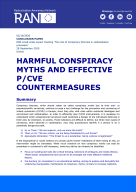Details
- Publication date
- 23 November 2020
- Author
- Directorate-General for Migration and Home Affairs
- RAN Publications Topic
- Alternative and counter narratives
Description
Conspiracy theories, which should rather be called conspiracy myths due to their anti- or pseudoscientific narratives, continue to pose a key challenge for the prevention and countering of violent extremism (P/CVE) in Europe, since they play vital roles within extremist ideologies and recruitment and radicalisation.
In order to efficiently plan P/CVE interventions, it is necessary to understand which conspiratorial narratives could constitute a danger to the individuals believing in them and, by extension, to society. Fixed indicators are difficult to define, but three main types of narratives, when believed in combination, may help practitioners identify if a person is on a potentially dangerous path:
- Us vs Them: “We are superior, only we know the truth!”
- Them vs Us: “We are victims, we are being threatened by evil forces!”
- Apocalyptic dimension: “The threat to us is existential, hence violence is legitimate!”
If the biographical or social context of a person gives further indications of them being at risk, an intervention might be warranted. While much research on how conspiracy myths can best be prevented or countered is still necessary, some key advice can already be identified:
- Focus on building skill sets like critical thinking, tolerance of ambiguity and media literacy. These classic competencies have proven to be amongst the most effective resilience factors.
- Pre-bunking (or inoculation) in an educational setting, aiming to explore and demystify the underlying manipulation mechanisms of conspiracy myths, is likely to increase resilience.

